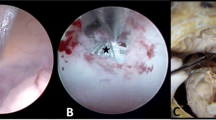Abstract
Purpose
The tuber cinereum (TC) comprises the hypothalamic gray matter that forms the anterior portion of the third ventricle floor. However, since it has been rarely documented in previous neuroimaging investigations, the aim of the current study was to explore the morphology of the TC using magnetic resonance imaging (MRI).
Methods
Ninety-two patients were enrolled in this study. Following initial examination with conventional MRI sequences, a contrast study using intravenous gadolinium injection was performed in thin-sliced sections.
Results
The TC, which was commonly defined as a linear, enhancing structure on the midsagittal section, was identified in all 92 cases. In 83% of cases, the third ventricle floor had a gentle inflection at the junctional site between the median eminence and TC. The angle formed between the line parallel to the TC and the horizontal line showed considerable variability, which ranged from 0.5° to 56°. Furthermore, a non-enhancing segment of variable length was identified in the posterior-most TC. In 11% of cases, the midline TC was enhanced over the whole length.
Conclusions
Since the most part of the midline TC was enhanced with intravenous gadolinium injection, it may function as a circumventricular organ. The TC should be evaluated with contrast sagittal MRI prior to performing surgery with management of the anterior third ventricle floor.







Similar content being viewed by others
References
Aydin S, Yilmazlar S, Aker S, Korfali E (2009) Anatomy of the third ventricle in relation to endoscopic ventriculostomy. Clin Anat 22:916–924
Benarroch EE (2011) Circumventricular organs: receptive and homeostatic functions and clinical implications. Neurology 77:1198–1204
Castro-Dufourny I, Carrasco R, Prieto R, Barrios L, Pascual JM (2015) The infundibulo-tuberal syndrome caused by craniopharyngiomas: clinicopathological evidence from an historical French cohort (1705–1973). Pituitary 18:642–657
Duvernoy HM, Risold PY (2007) The circumventricular organs: an atlas of comparative anatomy and vascularization. Brain Res Rev 56:119–147
Ferguson AV (2014) Circumventricular organs: integrators of circulating signals controlling hydration, energy balance, and immune function. Frontiers in neuroscience. Neurobiology of body fluid homeostasis: transduction and integration. Boca Raton (FL): CRC Press/Taylor & Francis. (Chapter 2)
Ganong WF (2000) Circumventricular organs: definition and role in the regulation of endocrine and autonomic function. Clin Exp Pharmacol Physiol 27:422–427
Glastonbury CM, Osborn AG, Salzman KL (2011) Masses and malformations of the third ventricle: normal anatomic relationships and differential diagnoses. Radiographics 31:1889–1905
Horsburgh A, Massoud TF (2013) The circumventricular organs of the brain: conspicuity on clinical 3 T MRI and a review of functional anatomy. Surg Radiol Anat 35:343–349
Horsburgh A, Matys T, Kirollos RW, Massoud TF (2013) Tuber cinereum proximity to critical major arteries: a morphometric imaging analysis relevant to endoscopic third ventriculostomy. Acta Neurochir (Wien) 155:891–900
Longatti P, Basaldella L, Sammartino F, Boaro A, Fiorindi A (2013) Fluorescein-enhanced characterization of additional anatomical landmarks in cerebral ventricular endoscopy. Neurosurgery 72:855–860
Marinković SV, Milisavljević MM, Marinković ZD (1989) Microanatomy and possible clinical significance of anastomoses among hypothalamic arteries. Stroke 20:1341–1352
Morita S, Miyata S (2012) Different vascular permeability between the sensory and secretory circumventricular organs of adult mouse brain. Cell Tissue Res 349:589–603
O’Rahilly R, Müller F (1990) Ventricular system and choroid plexuses of the human brain during the embryonic period proper. Am J Anat 189:285–302
Rhoton AL Jr (2002) The lateral and third ventricles. Neurosurgery 51(4 Suppl):S207–S271
Sughrue ME, Chiou J, Burks JD, Bonney PA, Teo C (2016) Anatomic variations of the floor of the third ventricle: an endoscopic study. World Neurosurg 90:211–227
Tubbs RS, Hattab EM, Loukas M, Chern JJ, Wellons M, Wellons JC 3rd, Iskandar BJ, Cohen-Gadol AA (2012) Histological analysis of the third ventricle floor in hydrocephalic and nonhydrocephalic brains: application to neuroendocrine complications following third ventriculostomy procedures. J Neurosurg Pediatr 9:178–181
Acknowledegements
This work was not supported by grant funding.
Author information
Authors and Affiliations
Corresponding author
Ethics declarations
Conflict of interest
The authors have no conflicts of interest to declare concerning the materials and methods used, or the results presented in the current study.
Rights and permissions
About this article
Cite this article
Tsutsumi, S., Ono, H. & Yasumoto, Y. The tuber cinereum as a circumventricular organ: an anatomical study using magnetic resonance imaging. Surg Radiol Anat 39, 747–751 (2017). https://doi.org/10.1007/s00276-016-1806-7
Received:
Accepted:
Published:
Issue Date:
DOI: https://doi.org/10.1007/s00276-016-1806-7




